
The Whole Foods Trend
As the season heads toward Thanksgiving, it’s ironic to hear people complain about the amount of food they throw away. With consumers shopping for a bounty of fresh food, it often means that wilted or spoiled items, together with uneaten leftovers, are tossed in the trash.
The next time you shop, observe what food is already cleaned and processed. Carrots are bagged in bite-size pieces; celery is trimmed of its leaves. Broccoli crowns have had their stalks chopped off. Vegetables are shrink-wrapped in Styrofoam trays, and fruit mix chills out in plastic containers. The meat case displays tidy packages of beef, pork, lamb and poultry. We look at the processed, packaged goods as food and rarely think in terms of “whole food.” What we take home is often one small part of a whole animal, fruit or vegetable.
I doubt that anyone intentionally wastes food, but in the United States somewhere between 30 percent and 40 percent of our food supply goes to waste each year. That equates to 20 pounds of food per person–per month. Could it be that we waste what we buy because we rarely see “the whole” of what we’re eating?
Yet some people are becoming mindful of what they purchase and how it is used. This goes beyond basing your shopping list on a meal plan. You can be intentional, planning for Monday’s leftover roast chicken to be used for chicken tostadas on Wednesday. However, I am talking about something completely different, a new way of thinking that goes beyond these smart shopping choices: Farm-to-table, nose-to-tail, root-to-stalk cooking.
So what is this new philosophy all about? In fact, it’s not new at all; it goes back to how food was produced just a few generations ago, before industrialization brought changes to farm practices. It is best summed up by the old phrase “Waste not, want not.”
Let’s talk first about the parts of an animal that we no longer see at the meat counter: offal. It’s no coincidence that this word sounds identical to “awful.” The word offal is derived from Middle Dutch words meaning “off” and “fall,” essentially the “off-fall” from the butcher’s block. These items–pig’s snout and feet, organ meats such as liver and kidney, beef tripe–were not prime cuts, but they were edible. Offal was not tossed in the trash; it became known as the food of the poor.
Today, however, these “off-fall” cuts of meat are finding their way to expensive menus at high-end restaurants, in appetizers and main dishes featuring foods such as duck tongue, pork belly, pig ears, beef heart or blood sausage.
People who grew up on a farm or have experience as a butcher often learn to prepare and enjoy “variety meats” such as ox tails or beef tongue. It’s not that they are more adventurous eaters; they simply have more experience with the whole animal. If you take part in butchering any animal, it creates a sense of respect for all its parts. There’s an old farm saying that when a hog is butchered, every part is used except the oink. That saying still holds true today; what does not go into the meat case ends up either used in food products such as sausage, cheese and ice cream, or sold for use in a variety of industries, including pet food, cosmetics and pharmaceuticals.
Will home cooks embrace the nose-to-tail cooking philosophy? Perhaps. With farmers’ markets and farm-to-table CSA programs, consumers may have more direct contact with local farmers and butchers than they did, say, a generation ago. But it’s easier to implement root-to-stalk cooking in daily life, no matter where you shop. Foodies love using tender young beet leaves in salads, or braising the outer leaves of lettuce and radicchio as a side dish. Anyone can toss vegetable peelings into a plastic bag in their freezer for use in the next batch of soup stock. Even the most–shall we say, mature?–carrots, onions, celery and mushrooms produce great flavor when added to soup stock in the last hour of simmering. After they’re discarded, they can be used yet again; toss them into a compost heap, along with less desirable scraps such as egg shells or coffee grounds.
If you’re interested in nose-to-tail/root-to-stalk cooking, explore your local options. Attend events such as Offal Wonderful in Oakland, California, that feature classes with craft meat-cutters. Or seek out a cooking school, such as Haven’s Kitchen in New York City, which offers the opportunity to learn sustainable methods of preparing and cooking meats and seafood. Raid your refrigerator, pantry and garden to simmer a rich vegetable broth from scrubbed, chopped, unpeeled onions, carrots, chard, potatoes and herbs.
These small choices can make a big difference not only in how you cook, but also in whether or not your food dollars go to waste. Is there any better way to celebrate the harvest season all year long? HLM
Sources: ers.usda.gov, etymonline.com, havenskitchen.com and worldfooddayusa.org.







